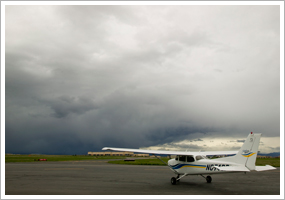| The following stories from the July 17, 2009, edition of AOPA ePilot were provided to AOPA members who expressed an interest in the particular subject areas. Any AOPA member can receive information tailored to their areas of interest by updating their preferences online. TRAINING TIPsHail
Turbulence is one of the hazards. Another is hail (METAR symbol: GR). Hail can be encountered at some distance from the cell where it formed. A pilot report (pirep) that includes hail is transmitted as an urgent pirep; hail of three-quarters of an inch in diameter or greater is included in convective sigmets (significant meteorological information) ( see Chapter 11 of the Pilot’s Handbook of Aeronautical Knowledge).
“Hail offers a definite hazard to aircraft. Updrafts lift supercooled drops of water above the freezing level; they fall out of the updraft, are lifted again, and begin collecting layers of ice as they move inside the thunderstorm cell. The stronger the updrafts, the larger the hailstones can grow. They can range from the size of a pea to more than 5 inches in diameter. Hailstones can either be ejected from the thunderstorm—as far as 20 miles from the cloud—or grow too large to be lifted and fall to the ground. Hail most often falls ahead of the advancing thunderstorm cell. It is recommended that pilots avoid thunderstorms by at least 20 miles from the edge of a storm cloud,” was the response to an inquiry about hail in the May 9, 2003, ePilot.
If this revises your sense of what constitutes a minimum safe distance from a thunderstorm along your route, take some time and review the AOPA Pilot Information Center document “ Thunderstorm Avoidance,” especially the section titled “Avoiding Thunderstorms Enroute.” The AOPA Air Safety Foundation also has an entire section devoted to thunderstorm awareness, including an interactive course, a Safety Advisor, a printable quick-reference card, and a quiz.
Another point about hail: It can severely damage an aircraft. See the July 2001 AOPA Pilot “Never Again” for an account of the impression an encounter with hail made on a Cessna 172’s occupants—and the aircraft itself. TRAINING PRODUCTS‘21st Century Flight Training’ from ASADoes new technology in the cockpit require improved teaching methods? Sean Lane, author of 21st Century Flight Training, sets up new training models and teaching methods to help resolve “the inherent conflict between technically advanced aircraft and an increasingly complex flight environment, and general aviation accident trends,” according to publisher Aviation Sciences and Academics Inc. The book is aimed at both students and CFIs, and flight instructor candidates are led through the development of a complete set of lesson plans. The soft-cover, 472-page book sells for $29.95 and is available through aviation retail outlets or online from ASA. Note: Products listed have not been evaluated by ePilot editors unless otherwise noted. AOPA assumes no responsibility for products or services listed or for claims or actions by manufacturers or vendors. FINAL EXAMQuestion: During the run-up for my last flight lesson, we noticed that the oil temperature gauge was reading “0.” We had been taxiing for a while and it was a pretty hot day, so it should have been reading at least a little higher. We decided to cancel the flight and switch to a different airplane. Is the oil temperature gauge a required instrument, and should we have canceled the flight?
Answer: According to FAR 91.205, the oil temperature gauge is a required instrument. You and your flight instructor made the right decision to terminate the flight and get the faulty instrument repaired. For more information on inoperative instruments and minimum equipment lists, check out this AOPA subject report. Got a question for our technical services staff? E-mail to [email protected] or call the Pilot Information Center, 800/872-2672. Don't forget the online archive of "Final Exam" questions and answers, searchable by keyword or topic. |
 All pilots learn to have a healthy respect for summer’s thunderstorms. Part of a skilled pilot’s ability to analyze weather is recognizing conditions that can start storms growing along a proposed route of flight. Ideally, you are safely on the ground when thunderstorms are sprouting, but the unexpected can happen. Plan B is to give convective weather the widest possible berth. Where some VFR pilots err is in underestimating the risks of straying too close to a storm cell.
All pilots learn to have a healthy respect for summer’s thunderstorms. Part of a skilled pilot’s ability to analyze weather is recognizing conditions that can start storms growing along a proposed route of flight. Ideally, you are safely on the ground when thunderstorms are sprouting, but the unexpected can happen. Plan B is to give convective weather the widest possible berth. Where some VFR pilots err is in underestimating the risks of straying too close to a storm cell.

